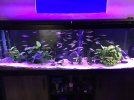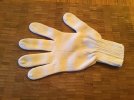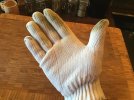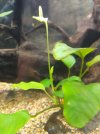Which Beamswork fixture do you have on this tank? And by fertilizers do you mean a liquid supplement, like SeaChem Flourish?...Plants are looking bad to me... Lots of yellow leaves. I have the lighting on for about 9 hrs a day, though its been reduced to setting 4 on the Beamswork, and have been adding ferts weekly but not sure what I need to do about that or if its the natural cycle of the plants. My instinct tells me to go up a setting on the lights... Any thoughts?...
You are using an out of date browser. It may not display this or other websites correctly.
You should upgrade or use an alternative browser.
You should upgrade or use an alternative browser.
Algae on anubias leaves, how to clean it?
- Thread starter DMD123
- Start date
Im using the full spectrum EA fixture. I have been using a Fluval brand called "Grow"Which Beamswork fixture do you have on this tank? And by fertilizers do you mean a liquid supplement, like SeaChem Flourish?
Well, I'm no plant expert, for sure, but I don't believe your issue is not enough light. I have a number of different Anubias in three different tanks (one 100 and two 125's), and I am getting good growth using Beamswork DA fixtures set at 10% for the 6500K LEDs (9 hours per day) and 100% for the actinic LEDs (12 hours per day). It is my impression that Anubias don't like to be fussed with once they've sent down roots; perhaps you should ease up on the gravel vacuuming in their vicinity? Good luck. 



Yeah, the problem with that is if you look hard enough on Google you will find the claimed culprit to be iron deficiency, phosphate deficiency, nitrate deficiency, etc. etc. You get the idea. I have a hard time believing that any of the liquid plant supplements don't provide an excess of everything, but I suppose doubling the dose is worth a try.Was Google searching and found something saying its Iron deficiency... Apparently not enough in the Fluval Grow formula?
fishguy1978
Legendary Member
The downside to fertilizing is that without accurate testing there really is no way of knowing what is lacking. There was a time when I was following SeaChem's dosing schedule on a CO2 injected tank and the results were not good. I was actually causing damage to my plants. During this same period I was maintaining a 90/110 mixed Malawi tank for a client. Filtration was an undergravel with 2 uplift tubes with powerheads and a canister filter. I was there monthly. Lighting was a simple 48in double tube fluorescent. The anubius (Barterii, Frazerii, Nana, maybe others) in that tank flourished without the addition of any ferts. Because this was a Malawi tank the fish were fed a spirulina based food.
I would try varying your light intensity or period. I have anubius in a variety of light settings currently. 55g Dwarf Sumbu tank has a 48in planted LED and 29g tanks under LED light strips from Current USA where the tanks on the end are receiving less light than middle tanks. Anubius is growing well in all of them. My photo period is 12hrs. I still have bottles of fert but haven't added any in months just regular ish water changes.

I would try varying your light intensity or period. I have anubius in a variety of light settings currently. 55g Dwarf Sumbu tank has a 48in planted LED and 29g tanks under LED light strips from Current USA where the tanks on the end are receiving less light than middle tanks. Anubius is growing well in all of them. My photo period is 12hrs. I still have bottles of fert but haven't added any in months just regular ish water changes.

Last edited:
@fishguy1978, what would you suggest then in my case. Increase the intensity of lighting for my 9hr time period? Or increase duration?
fishguy1978
Legendary Member
If algae is the concern then I would try decreasing intensity or duration. You might find better success with a low intensity long duration period. Nerites or mystery snails would also be an option. Nerites are my preferred when I don't have puffers to feed.
I agree; I'd go for decreasing the amount of light, not increasing it. As for nerites; that's already off the table because of the nuisance egg problem.If algae is the concern then I would try decreasing intensity or duration. You might find better success with a low intensity long duration period. Nerites or mystery snails would also be an option. Nerites are my preferred when I don't have puffers to feed.
There's another issue that no one has mentioned- the quality of the initial stock. Where did you get these plants? I never had any luck with Anubias from LFS's, they're OK for a while, then peter out. In contrast, all of the plants I've tried from reputable online suppliers have done fine.
lol, yep the snail egg problem. Male Nerites?
My stock came from Buce. They were very healthy deep green plants. I guess one issue is that many places do not raise these as fully submerged plants because they grow slower that way. then you get them and fully submerse them and the issues begin.
My stock came from Buce. They were very healthy deep green plants. I guess one issue is that many places do not raise these as fully submerged plants because they grow slower that way. then you get them and fully submerse them and the issues begin.
John58Ford
Well-Known Member
Plant growth issues really can be fun, most commercial fertilizers have glaring weaknesses if the user is using source water devoid of anything specific or unusual. A few brands consider different things normal and as we all know the water can be very different from town to town, source to source. I usually like to hit the guaranteed analysis of a fertilizer, and then break it down to search for clues on what we can look for in a deficient plants source water.
Gro says to add 5ml per 60 gallons. Just for scale the math on that says .3% (total nitrogen) at 5ml per 60 gallon would give you about .3%/45,500 or .000066% (.66ppm) dissolved nitrogen. That's one of the stronger 3 ingredients in this fertilizer. I see a lack of magnesium, calcium, and sulfur. maybe adequate ish potassium available as "k2o(equivalent)" but still low. Pretty solid iron though (1.5ppm, but no guidance on the chelation so best guess on the pH where it's effective, though they did say EDTA for the nitrogen giving you good odds at 4-6 pH, dtpa if you are in the normal range would be better). Though I don't think this is related to the yellow leaves, 1.5 ppm iron in the wrong chelation will bind with phosphate and precipitate giving a similar appearance to the white water algae bloom described a few hours after dosing.
Likely candidates (using folk method visual diagnosis) for yellow leaves are nitrogen, potassium, magnesium, copper, sulfur, and calcium (calcium especially if they are small and limp).
Where this matters for you, it's clear that gro+ assumed you have a "normal" calcium:magnesium: potassium balance in your water. This is commonly messed up in city treated water that needs to be softened, water softeners at home, mountain spring wells (my situation), or people running ro/di or bottled waters . As @fishguy1978 hinted at these are genuinely hard to test for but can be played with a bit safely. Assuming I'm not off the ranch too far here I could elaborate further on my theory (as minimalist regarding diy fertilizer vs commercial) but this rabbit hole is pretty crazy when uninvited lol.
Edited: as you will all figure out, I post from a phone and well, autocorrect and I have our disagreements.
Gro says to add 5ml per 60 gallons. Just for scale the math on that says .3% (total nitrogen) at 5ml per 60 gallon would give you about .3%/45,500 or .000066% (.66ppm) dissolved nitrogen. That's one of the stronger 3 ingredients in this fertilizer. I see a lack of magnesium, calcium, and sulfur. maybe adequate ish potassium available as "k2o(equivalent)" but still low. Pretty solid iron though (1.5ppm, but no guidance on the chelation so best guess on the pH where it's effective, though they did say EDTA for the nitrogen giving you good odds at 4-6 pH, dtpa if you are in the normal range would be better). Though I don't think this is related to the yellow leaves, 1.5 ppm iron in the wrong chelation will bind with phosphate and precipitate giving a similar appearance to the white water algae bloom described a few hours after dosing.
Likely candidates (using folk method visual diagnosis) for yellow leaves are nitrogen, potassium, magnesium, copper, sulfur, and calcium (calcium especially if they are small and limp).
Where this matters for you, it's clear that gro+ assumed you have a "normal" calcium:magnesium: potassium balance in your water. This is commonly messed up in city treated water that needs to be softened, water softeners at home, mountain spring wells (my situation), or people running ro/di or bottled waters . As @fishguy1978 hinted at these are genuinely hard to test for but can be played with a bit safely. Assuming I'm not off the ranch too far here I could elaborate further on my theory (as minimalist regarding diy fertilizer vs commercial) but this rabbit hole is pretty crazy when uninvited lol.
.
GUARANTEED ANALYSIS : Total Nitrogen (N) 0.3 %, Water Soluble Organic Nitrogen (from EDTA) 0.3%, Available Phosphate (P2O5) 0.01%, Available Potash (K2O) 0.4%, Boron (B) 0.001%, Copper (Cu) 0.0005%, Chelated Copper (Cu) 0,0005 %, Iron (Fe) 0.65%, Chelated Iron (Fe) 0.65 %, Manganese (Mn) 0.05%, Chelated Manganese (Mn) 0.05 %, Molybdenum (Mo) 0.0007%, Zinc (Zn) 0.003%, Chelated Zinc (Zn) 0.003 %,
ALSO CONTAINS NON-PLANT FOOD INGREDIENT: Thiamine HCl (Vitamin B1) 0.020%
GUARANTEED ANALYSIS : Total Nitrogen (N) 0.3 %, Water Soluble Organic Nitrogen (from EDTA) 0.3%, Available Phosphate (P2O5) 0.01%, Available Potash (K2O) 0.4%, Boron (B) 0.001%, Copper (Cu) 0.0005%, Chelated Copper (Cu) 0,0005 %, Iron (Fe) 0.65%, Chelated Iron (Fe) 0.65 %, Manganese (Mn) 0.05%, Chelated Manganese (Mn) 0.05 %, Molybdenum (Mo) 0.0007%, Zinc (Zn) 0.003%, Chelated Zinc (Zn) 0.003 %,
ALSO CONTAINS NON-PLANT FOOD INGREDIENT: Thiamine HCl (Vitamin B1) 0.020%
Edited: as you will all figure out, I post from a phone and well, autocorrect and I have our disagreements.
Last edited:
@lloyd378, did the Anubias Hastifolia you got from me survive? How are yours doing?
Speaking of plants, My Java fern that I put in my 30g puffer tank is continuing to get little sprouts. Ive propagated a couple onto rocks and also gave a few to @lloyd378. I do zero to this plant and its growing like a weed!
Speaking of plants, My Java fern that I put in my 30g puffer tank is continuing to get little sprouts. Ive propagated a couple onto rocks and also gave a few to @lloyd378. I do zero to this plant and its growing like a weed!
I was thinking my white water could also be from how Im dosing. I realized I am adding ferts right after my water change which involves dosing with Seachem Safe for chlorine, I dose at the same time with ferts. I read where someone was having some issues with this using Prime which is just the liquid form of Safe.
Last edited:
I did a small water change last night when I got home from work. It cleared up the white water a bit, added my Safe but no ferts. My timer was set to come on at 10am and turn off at 9pm with an hour of blue light before and after. I decided to add one hour to the lighting and have it come on at 9am with 1/2 hr of blue before. Did not change intensity and kept it at 4 for regular and 1 for blue. Just had duration of light a bit longer. Since the algae growth seems to be reasonable and not seeing a lot on the plants I decided to increase the time a little and wait and see how it goes. Might increase ferts but do it on days when water changes are not happening to see if that fixes white water issues.
This is an old thread, but I just realized that I never posted my solution to the diatoms-on-Anubia-leaf problem. I was getting exactly the same thing as shown in your first pic, but as the plants grew and/or I added more plants, it seemed to lessen. Even so, I found this little device to be very useful for cleaning off the Anubia leaves in situ-


It's a microfiber glove, so if you gently rub the leaves between your fingers (as @fishguy1978 suggested) it's slightly more abrasive than your fingertips, but still plenty gentle, so the diatoms come off in no time. You can buy these from specialty automotive shops; they're used for detailing cars before Concours events; the judges also use them to search for dirt. Anyway, they do a nice job for me.
Anyway, they do a nice job for me.


It's a microfiber glove, so if you gently rub the leaves between your fingers (as @fishguy1978 suggested) it's slightly more abrasive than your fingertips, but still plenty gentle, so the diatoms come off in no time. You can buy these from specialty automotive shops; they're used for detailing cars before Concours events; the judges also use them to search for dirt.
